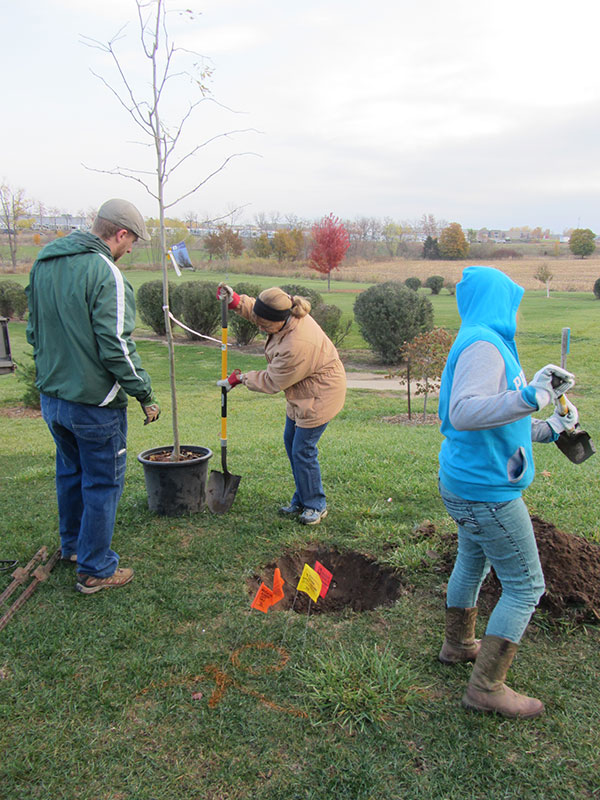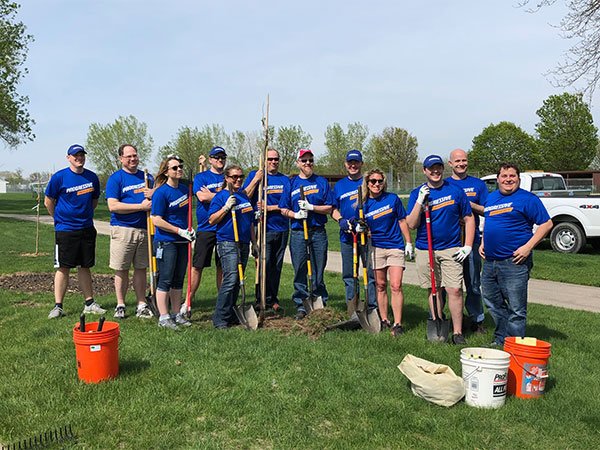Hiawatha Urban Forestry Tree Information
Hiawatha is dedicated to managing the community’s urban tree canopy. There are more than 3,000 public trees identified in the community tree inventory. Hiawatha works hard to address trimming, removals, pest and disease concerns and promote overall tree health.
Public trees bring many benefits to the urban landscape including increased property values, reduced air and noise pollution, storm water collection and erosion prevention. Trees promote lower energy costs by shading structures from the summer sun and buffering from cold winter winds. Many studies show statistical information supporting that urban trees can modify the local climate, add beauty and diversity, increase economic stability, and even improve mental and physical health.
Trees are a sustainability power tool and provide more than just an aesthetic perk in the urban setting. More like another form of green infrastructure, trees are equally as important as any other types of the public foundation, such as roads, sidewalks, buildings, water supply, energy grids, institutions, parks and trail systems. Without the natural impact of trees, a community can fall short of its full potential to provide for residents. Hiawatha is committed to a new approach to design healthier and happier spaces that allow daily connection to the natural world.

Hiawatha Tree Planting and Care Guide
📺 Marketing tree planting video
Online Hiawatha Tree Planting and Care Guide.pdf
Hiawatha Tree Ordinance
This chapter describes provisions on trees and vegetation in any public area in Hiawatha.
Planting Placement and Recommended/Prohibited List
Appendix A - Planting Guidelines
Tree Permit
Planting trees in the right-of-way (the public space between the street curb and sidewalk) requires a tree planting permit. There are guidelines for placement, size, and species so that trees in the right-of-way do not block traffic, signs, pedestrians, or utilities.
Right-of-Way Tree Planting Permit.pdf
Tree Resources for Homeowners
Check out these resources to help guide you with your tree planting needs.
📺 Iowa DNR informational tree planting video
Trees Forever- How to Plant A Tree
Iowa Department of Natural Resources- Tree Resources and Links
Iowa State University Extension- Community Tree Planting and Care Guide
Iowa State University Extension- Sustainable Urban Landscapes
International Society of Arboriculture Tree Owner Resources
Call 811 - Before digging or planting
You are required to contact Iowa One Call at 811 or (1-800-292-8989) to locate utilities. You can reach them 24/7. It is important to be mindful of underground and overhead utilities when planting in the ROW. Overhead utilities may prevent planting a tree or can limit planting to smaller ornamental varieties. Be aware when planting, that any damage to privately planted vegetation that occurs during repair and maintenance of utilities is at the expense of the homeowner. http://www.iowaonecall.com/

Did Your Tree Survive the Derecho?
Does it still look pretty rough? There are a few things to consider as we move into the next growing season that may help your survivor trees adapt to the stress and change that took place last August. It is important to remember that the trees have already sustained a great deal of trauma and we don’t want to add any unnecessary stress as they respond. Here are a few things you can do to promote positive reaction this spring:
- It may be best to monitor rather than take heavy pruning action
- Reduce (cut) broken, torn or splintered stubs back to the next branch junction
- If is it a primary limb that goes back to the main trunk, it can be either cut back to the trunk OR a clean cut can be made just behind where the branch failed to minimize the amount of exposed wood, the remaining stub will push new growth in following seasons
- EXPECT SPROUTING! This is a sign of stress. As new sprouts develop, sprouts with desirable form can be left to replace canopy while others can be thinned or removed to discourage clumping of new branching
- The tree gets energy from the leaves that conduct photosynthesis, if a large percentage of canopy was lost the tree will try to replace it by sprouting to maximize energy production
- Plan to monitor the trees over the next five years. Some may still decline and die due to stress in the coming seasons. Survivors will need mild attention to train new growth
- DO NOT get carried away! Any material removed cannot be put back on, but you can always take it off later. Survivor trees will take many years to recover and stabilize growing patterns.
- WATER: Even mature trees can stress during dry periods. A little water can relive stress during the hot and drier months of summer.
- For more information about tree care visit the Tree Resources for Homeowners on this page.
